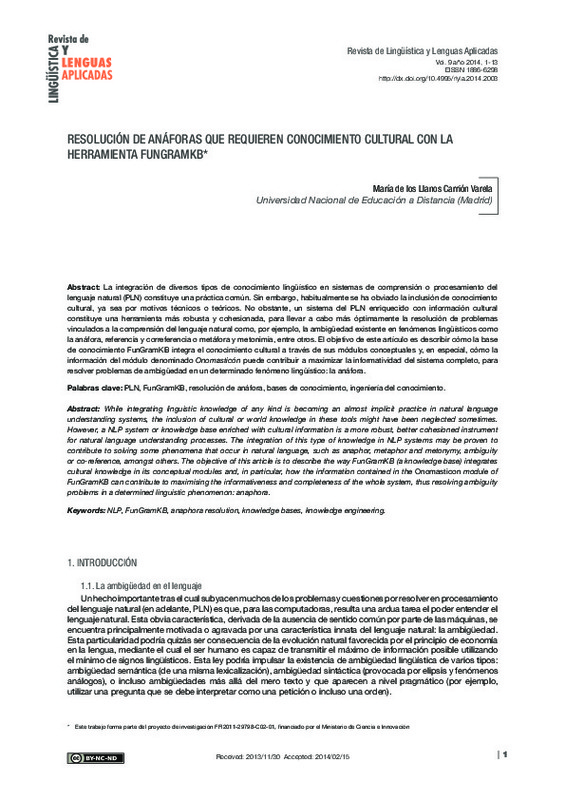JavaScript is disabled for your browser. Some features of this site may not work without it.
Buscar en RiuNet
Listar
Mi cuenta
Estadísticas
Ayuda RiuNet
Admin. UPV
Resolución de anáforas que requieren conocimiento cultural con la herramienta Fungramkb
Mostrar el registro sencillo del ítem
Ficheros en el ítem
| dc.contributor.author | Carrión Varela, María de los Llanos
|
es_ES |
| dc.date.accessioned | 2014-11-26T08:57:11Z | |
| dc.date.available | 2014-11-26T08:57:11Z | |
| dc.date.issued | 2014-07-01 | |
| dc.identifier.issn | 1886-2438 | |
| dc.identifier.uri | http://hdl.handle.net/10251/44855 | |
| dc.description.abstract | [EN] While integrating linguistic knowledge of any kind is becoming an almost implicit practice in natural language understanding systems, the inclusion of cultural or world knowledge in these tools might have been neglected sometimes. However, a NLP system or knowledge base enriched with cultural information is a more robust, better cohesioned instrument for natural language understanding processes. The integration of this type of knowledge in NLP systems may be proven to contribute to solving some phenomena that occur in natural language, such as anaphor, metaphor and metonymy, ambiguity or co-reference, amongst others. The objective of this article is to describe the way FunGramKB (a knowledge base) integrates cultural knowledge in its conceptual modules and, in particular, how the information contained in the Onomasticon module of FunGramKB can contribute to maximising the informativeness and completeness of the whole system, thus resolving ambiguity problems in a determined linguistic phenomenon: anaphora. | es_ES |
| dc.description.abstract | [ES] La integración de diversos tipos de conocimiento lingüístico en sistemas de comprensión o procesamiento del lenguaje natural (PLN) constituye una práctica común. Sin embargo, en habitualmente se ha obviado la inclusión de conocimiento cultural, ya sea por motivos técnicos o teóricos. No obstante, un sistema del PLN enriquecido con información cultural constituye una herramienta más robusta y cohesionada, para llevar a cabo más óptimamente la resolución de problemas vinculados a la comprensión del lenguaje natural como, por ejemplo, la ambigüedad existente en fenómenos lingüísticos como la anáfora, referencia y correferencia o metáfora y metonimia, entre otros. El objetivo de este artículo es describir cómo la base de conocimiento FunGramKB integra el conocimiento cultural a través de sus módulos conceptuales y, en especial, cómo la información del módulo denominado Onomasticón puede contribuir a maximizar la informatividad del sistema completo, para resolver problemas de ambigüedad en un determinado fenómeno lingüístico: la anáfora. | es_ES |
| dc.description.sponsorship | Este trabajo forma parte del proyecto de investigación FFI2011-29798-C02-01, financiado por el Ministerio de Ciencia e Innovación | |
| dc.language | Español | es_ES |
| dc.publisher | Editorial Universitat Politècnica de València | |
| dc.relation.ispartof | Revista de Lingüística y Lenguas Aplicadas | |
| dc.rights | Reserva de todos los derechos | es_ES |
| dc.subject | NLP | es_ES |
| dc.subject | FunGramKB | es_ES |
| dc.subject | Anaphora resolution | es_ES |
| dc.subject | Knowledge bases | es_ES |
| dc.subject | Knowledge engineering | es_ES |
| dc.subject | PLN | es_ES |
| dc.subject | Resolución de anáfora | es_ES |
| dc.subject | Bases de conocimiento | es_ES |
| dc.subject | Ingeniería del conocimiento | es_ES |
| dc.title | Resolución de anáforas que requieren conocimiento cultural con la herramienta Fungramkb | es_ES |
| dc.type | Artículo | es_ES |
| dc.date.updated | 2014-11-26T08:33:11Z | |
| dc.identifier.doi | 10.4995/rlyla.2014.2003 | |
| dc.relation.projectID | info:eu-repo/grantAgreement/MICINN//FFI2011-29798-C02-01/ES/DESARROLLO DE UN SISTEMA DE REPRESENTACION SEMANTICO-CONCEPTUAL Y SU IMPLEMENTACION EN UN ALGORITMO DE ENLACE BIDIRECCIONAL SINTAXIS-SEMANTICA/ | es_ES |
| dc.rights.accessRights | Abierto | es_ES |
| dc.description.bibliographicCitation | Carrión Varela, MDLL. (2014). Resolución de anáforas que requieren conocimiento cultural con la herramienta Fungramkb. Revista de Lingüística y Lenguas Aplicadas. 9:1-13. https://doi.org/10.4995/rlyla.2014.2003 | es_ES |
| dc.description.accrualMethod | SWORD | es_ES |
| dc.relation.publisherversion | https://doi.org/10.4995/rlyla.2014.2003 | es_ES |
| dc.description.upvformatpinicio | 1 | es_ES |
| dc.description.upvformatpfin | 13 | es_ES |
| dc.type.version | info:eu-repo/semantics/publishedVersion | es_ES |
| dc.description.volume | 9 | |
| dc.identifier.eissn | 1886-6298 | |
| dc.contributor.funder | Ministerio de Ciencia e Innovación | |
| dc.description.references | ALLEN, J. F., & FERGUSON, G. (1994). Actions and Events in Interval Temporal Logic. Journal of Logic and Computation, 4(5), 531-579. doi:10.1093/logcom/4.5.531 | es_ES |
| dc.description.references | Halliday, M.A.K. y Hasan, R. (1976). Cohesion in English. London: Longman. | es_ES |
| dc.description.references | Mitkov, R. (2002). Anaphora Resolution. Pearson Education Limited. Great Britain: Longman. | es_ES |
| dc.description.references | Peri-án Pascual, C. y Arcas Túnez, F. (2007). "Cognitive modules of an NLP knowledge base for language understanding", Procesamiento del Lenguaje Natural 39, 197-204. | es_ES |
| dc.description.references | Peri-án Pascual, C. y Arcas Túnez, F. (2008). "A cognitive approach to qualities for NLP", Procesamiento del Lenguaje Natural 41, 137-144. | es_ES |
| dc.description.references | Peri-án Pascual, C. y Arcas Túnez, F. (2010a), "Ontological commitments in FunGramKB", Procesamiento del Lenguaje Natural 44, 27-34. | es_ES |
| dc.description.references | Peri-án Pascual, C. y Mairal Usón, R. (2009). "Bringing Role and Reference Grammar to natural language understanding", Procesamiento del Lenguaje Natural 43, 265-273. | es_ES |
| dc.description.references | Peri-án Pascual, C. y Mairal Usón, R. (2010). "La gramática de COREL: un lenguaje de representación conceptual", Onomázein 21, 11-45. | es_ES |








